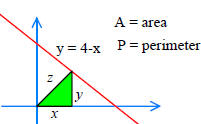Quadratic Function
DEFINITION.
A quadratic function is a polynomial of degree 2:

The graph is a parabola.
• If  a > 0, the horns point up.
a > 0, the horns point up.
• If a < 0, the horns point down.
If a < 0, the horns point down.
• If |a| > 1, the parabola is narrower than y
= x2.
If |a| > 1, the parabola is narrower than y
= x2.
•  If |a| < 1, the parabola is wider than y =
x2.
If |a| < 1, the parabola is wider than y =
x2.
Determine the shape of the following graphs. Pick the
shape below.

Given 
Get the roots by factoring or using the quadratic formula:
 . No roots if
. No roots if

COMPLETING THE SQUARE THEOREM. Every quadratic
function may be written in the form:

where  is the vertex (or nose) of the
parabola.
is the vertex (or nose) of the
parabola.
Proof. Given

• Factor the a out of the ax2+bx part.
• Divide the new coefficient of x by 2 and square.
Add this to complete the square.
• Anything which is added must also be subtracted to
preserve equality.
• Find the roots (the roots are the x-intercepts).
• Write in completed square form:![]()
• Graph. On the graph list both coordinates of the vertex.

Find the vertex.
Find the graph with the correct shape and position.

Find the roots. x = ?, ?
Write equation in the form: 
Find the vertex.

WORD PROBLEMS
• Draw the picture. Indicate the variables in the picture.
• Write the given equations which relate the variables.
• Solve for the wanted quantities.
 The perimeter of a rectangle is 10 feet.
The perimeter of a rectangle is 10 feet.
Express the area A in terms of the width x.
 The area of a rectangle is 10 square feet.
The area of a rectangle is 10 square feet.
Express the perimeter P in terms of the width x.
List the given.
Write the perimeter as a function of x
 The corner of a
triangle lies on the line
The corner of a
triangle lies on the line 
Express the triangle’s area and perimeter in terms of the
base x.

The area of an isosceles triangle is 16.
 Write the triangle’s height h in terms of its
width w.
Write the triangle’s height h in terms of its
width w.
 Write the triangle’s width w in terms of its
height h.
Write the triangle’s width w in terms of its
height h.

The curved surface
area is the area of the
can’s side, excluding
the top and bottom
 The height of a can
(right circular cylinder)
The height of a can
(right circular cylinder)
is three times the radius.
Express the radius as a function
of the curved surface area.
 The height of a can (right circular cylinder)
The height of a can (right circular cylinder)
is four times the radius.
Express the curved surface area as a function
of the radius.


